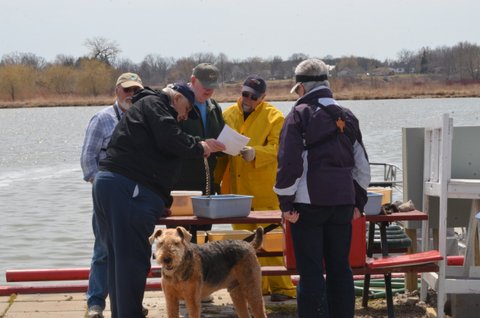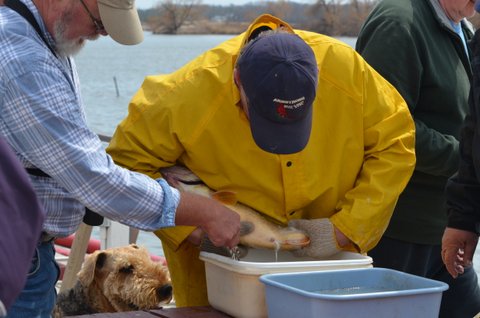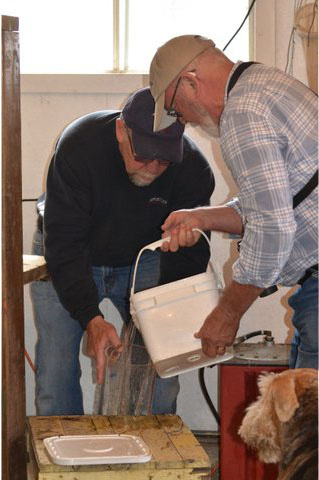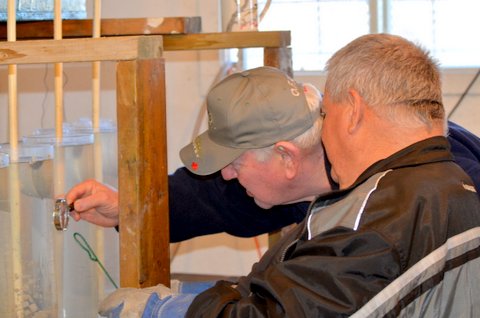Background

The DHA Walleye Hatchery consisting of a Bell Jar hatching operation and a rearing pond has operated for some 29 years. Club members recognized the need to replenish once abundant walleye in the Southern sections of the Grand R to bring back the historic fisheries that were favoured by anglers. Poor water quality had degraded the River’s fisheries to unacceptable levels. DHA Club leaders like Baldy Dolan, in cooperation with OMNR, received support and raised funds to build and operate the fish hatchery. Funding from DHACC Club functions MNR’s CFWIP, OFAH, GRCA helped to off-set expenses and still do. Early sources of fertilized eggs (gametes) were obtained from adult walleye transported from the Thames River. More recently Improved Lake and River conditions along with supplemental stocking have restored a walleye run to the Grand River.
How it Operates
Each spring as walleye start to spawn the hatchery operations get under way. At the club pond water is pumped into the tubs and clean bell jars. Permits to collect, hatch and rear (aquaculture) and stock walleye are obtained from MNR and Hatchery funding is applied for from OFAH Community Hatchery Program.

MNR from Port Dover’s Lake Erie Management Unit along with DHA Conservation members and Members from Port Colborne and Ft Erie Conservation Clubs schedule time to collect adult walleye. The Lake Unit brings their electro-shocking boat and our “partners in conservation” boat to collect walleye. The fish are processed at Riverside measured, tagged with a jaw and PIT tag, checked for ripeness and released upstream of the Dunnville dam/weirs. Females and males considered ripe are held for eggs and milt. The fertilizing also at Riverside results in gametes for our hatchery. Three bell jars containing gametes tumbling in water are closely monitored for a month by Dale, Lew,Ted and Felix. Dead/diseased eggs are repeatedly removed.
Cleaning of eggs is also needed occasionally.
As gametes develop and darken eyes, or eyed eggs, signal hatching is about to begin. Larvae hatch as sac fry and swim up to flow to a screened basket. The larvae are then transferred to the large aerated walleye rearing pond. They feed on plankton and invertebrates augmented by fertilizer and mash slung into the pond by Lew. When they reach fingerling size, ideally before they feed on each other, the walleye are stocked in the Grand River Given the many variables at hand we continue to learn and improve this process. More assistance from interested club members would smooth out the timing.

Synopsis
A peak of 30K fingerlings were reportedly stocked to supplement angling in the Grand R above Dunnville Dams in the 90’s– 15K being the average number.
In 2013 no walleye eggs hatched. This year we had a small hatch in June and stocked some 20 larger than normal young walleye into the Grand late July. Reason being they cannibalized the smaller fry so a shorter time in the rearing pond will be observed next year (temperature and manpower dependant).
OFAH/MNR CHP funded Improvements to the Hatchery and pond began last year and are ongoing.
We need more assistance from interested members April through June and into July to continue with this activity Early sources of fertilized eggs (gametes) were obtained from adult walleye transported from the Thames River. More recently Improved Lake and River conditions along with supplemental stocking have restored a walleye run to the Grand River .
Write up provided by:
Felix Barbetti, DHA Conservation Chair
